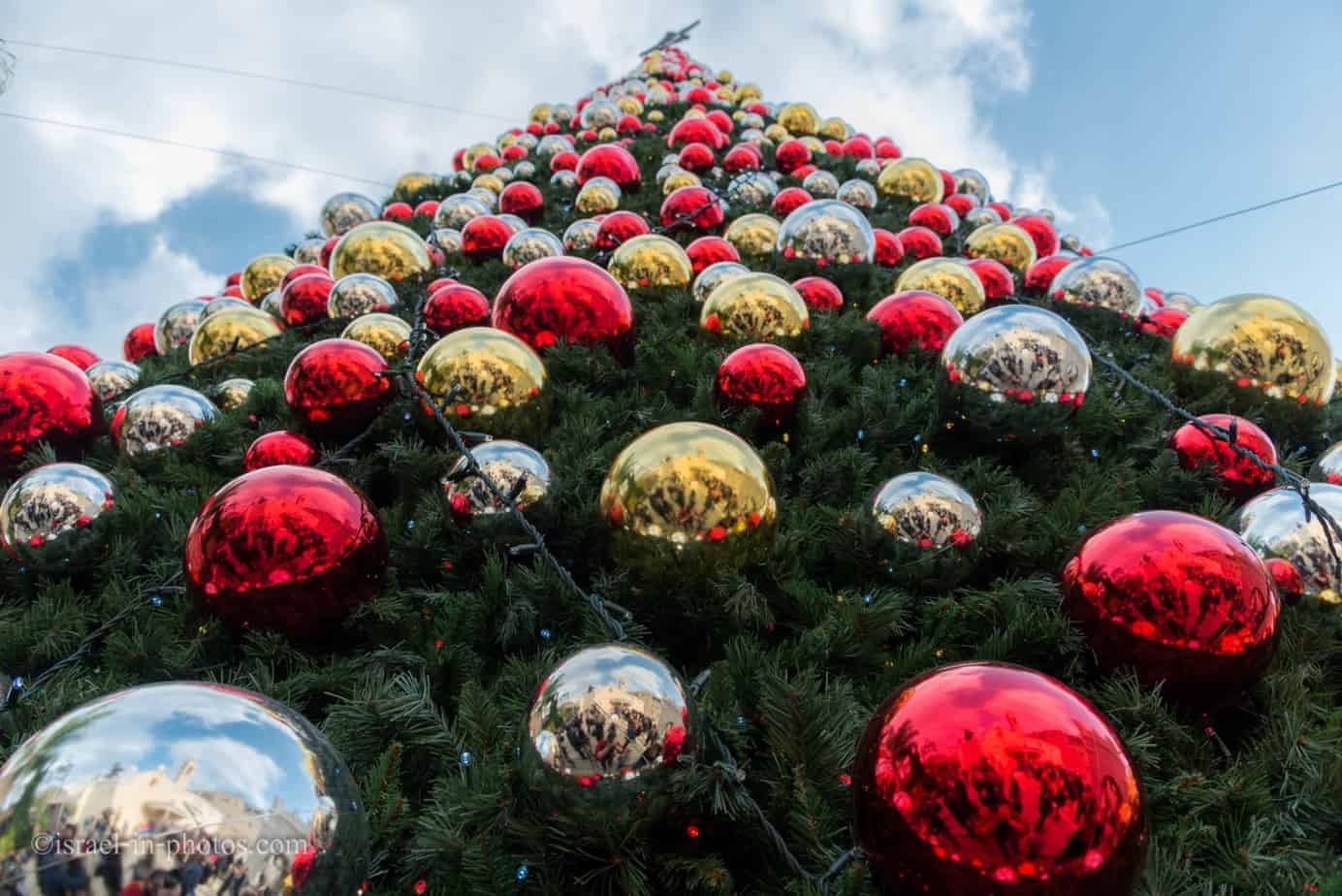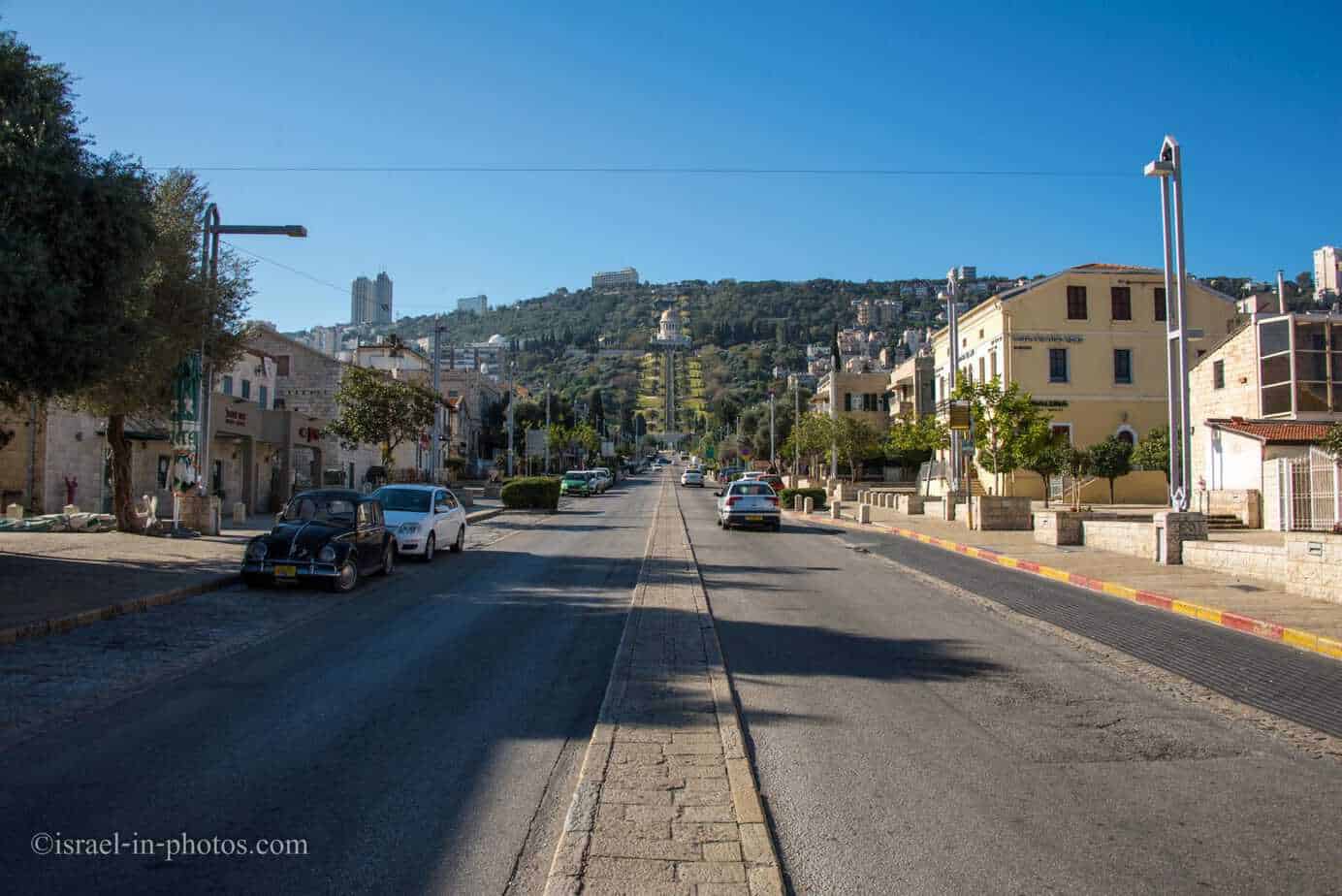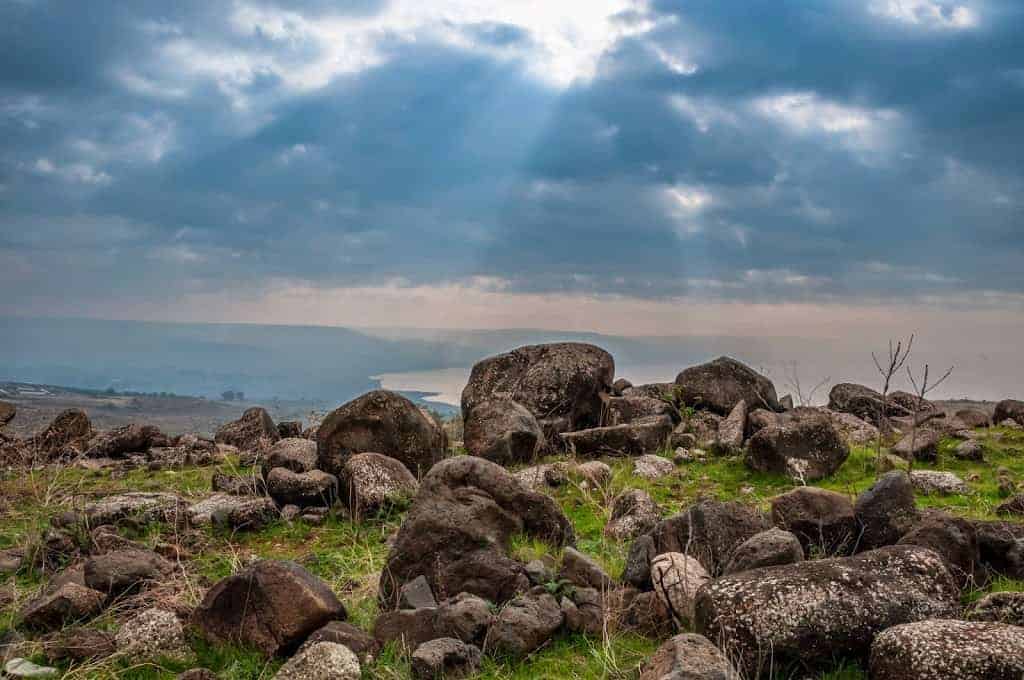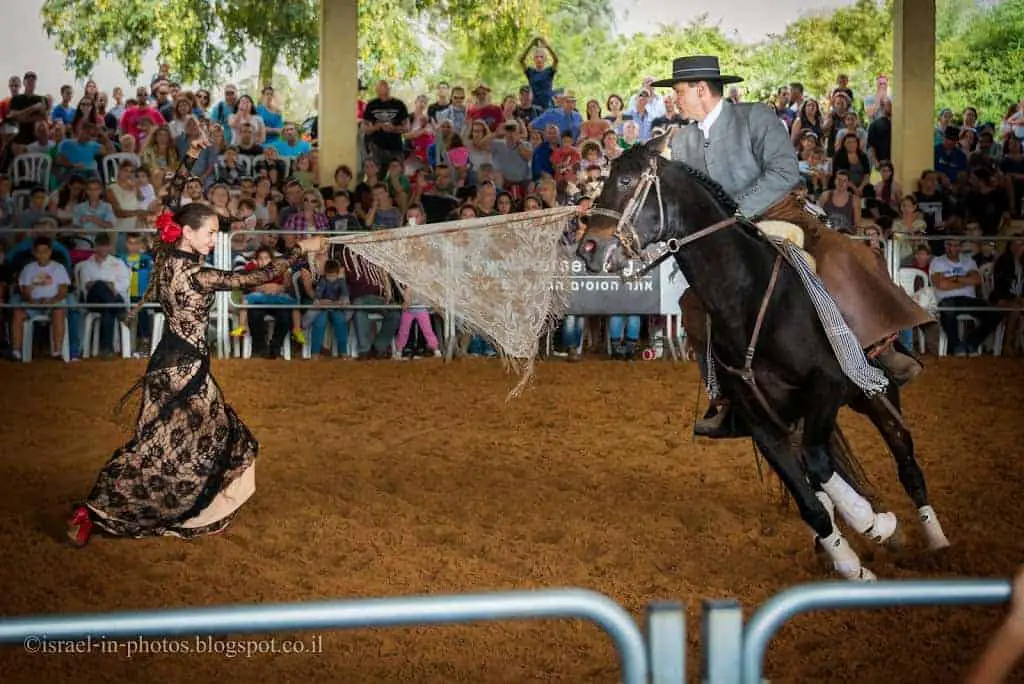Nazareth – Visitors Guide (Top Attractions and More)
Nazareth is a city in northern Israel, where according to the New Testament, Jesus spent his childhood. Hence it became a center of Christian pilgrimage.
In this guide, we will go over the most popular attractions in Nazareth and answer common questions.
Table of Contents
What does the name Nazareth mean?
Let me start by saying that the origin of the name is unknown. But since Nazareth is an ancient Jewish village, the term probably originates in a Hebrew word. Moreover, during my research, I saw two versions repeatedly. Let’s go over these variants and explain them.
Nazareth most likely comes from the Hebrew word Netzer, which means a branch. Alternatively, it could come from Hebrew Nazur, meaning guarding.
Branch
Some suggest the Book of Isaiah 11:1:
A shoot will come up from the stump of Jesse; from his roots a Branch will bear fruit.
Some see this as a hint that Jesus is a descendant of the house of David.
Guarding
The mountain on which Nazareth stands overlooks the Jezreel Valley and can serve as a defensive station.
Map
Directions for drivers: Link to Waze and Link to Google Maps
Directions for public transport: Link to Moovit
Interactive map of the area:
Directions
If you are using public transport, you can use the train and a variety of buses. Here is already a preset link to Moovit that will lead you near the Church of the Annunciation. Just enter your starting point, and you will get the updated directions.
And if you are driving, then you will need to find parking. But I have to warn you. Traffic in Nazareth is heavy and inconvenient (see the Traffic section below). So even if you have a car, consider public transport.
Parking
There are several paid parking lots in the center of Nazareth. During my latest visit, I parked at Iksal Street 9. But there are other places as well.

Churches of Nazareth
There are many churches in Nazareth. But in this section, we will start with the most popular ones: the Church of the Annunciation, Saint Joseph’s Church, and the Greek Orthodox Church of the Annunciation.
Church of the Annunciation
According to Catholic tradition, the Church of the Annunciation is where the house of the Virgin Mary once stood and where the angel Gabriel appeared to her and announced that she would conceive and bear the Son of God, Jesus.
Saint Joseph’s Church
During the 7th century, travelers pointed out that a place near the Church of the Annunciation was the carpentry workshop of Joseph, father of Jesus. And according to more recent tradition, this place is identified as “The House of Joseph.”
You can find additional information about this church in the guide to the Church of the Annunciation.

Greek Orthodox Church of the Annunciation
According to Eastern Orthodox belief, the Greek Orthodox Church of the Annunciation is positioned where Virgin Mary drew water at the Annunciation time.
Note: This church is also called Saint Gabriel Church.
Note: As the following photo shows, the Christmas tree is usually near Saint Gabriel Church.

Synagogue Church
The Synagogue Church, also known as Greek Catholic Church, is less popular than the first two. Nevertheless, it is worth stopping there if you are in Nazareth.
According to tradition, this church is built on the ruins of the ancient synagogue where Jesus studied and prayed.
In Arabic, it is known as “Madrasset El-Massiach” (The Messiah Academy). The Synagogue Church is located in the heart of the Old Market, between the stores. There is a small courtyard leading to a special church with a sign above its crossbar: The Synagogue.
The edifice has a unique structure; the floor is sunken around 1.5 meters underground, has an arched shape with benches along the walls, a podium, and an altar.According to Christian tradition, the Church is built on top of the ruins of a synagogue where Jesus studied and prayed. It is also the site where he carried his famous sermon on Saturday (Matthew 13, Mark 6, Luke 4), declaring himself as the Messiah to his Jewish village members. This sermon infuriated the worshippers who dragged him to Mount Precipice, planning to push him off, but he jumped and disappeared.
During Byzantine times, Christian believers started attending the place as a Church, and in Medieval times the synagogue was turned into a church. The Saturday Sermon story was ascribed to it.
The Synagogue Church currently belongs to the Greek-Catholic community, after Daher al-Omar handed it over to them from the Franciscans.Next to the historical Synagogue Church, a new church was built in 1887 (The New Synagogue Church). It is decorated with impressive wall paintings of Jesus as a baby, an adolescent, and a King.
Source: nazarethinfo.org
Synagogue Church is located at 6150 Street 7-1, Nazareth. And the opening hours are Monday – Saturday: 8:00 – 12:00 and 14:00 – 19:00.
Nazareth Village
Nazareth Village is an open-air museum where you can see how people lived at the time of Jesus.
Set on the outskirts of old Nazareth, the Nazareth Village is built on ancient agricultural land that boasts the area’s last remaining first-century wine press. The original farm has been restored with its ancient wine press, terraces, irrigation system, and stone quarry, and exact replicas of first-century houses, a synagogue, a watchtower, mikveh, and olive presses have been carefully constructed using the original building methods and materials.
Together, these elements form the Nazareth Village, an authentic first-century farm and archaeologically accurate re-creation of the hometown of Jesus with real ties to the life and time of His friends, family, and fellow Nazarenes.
Source: official site
Entry to Nazareth Village is by guided tour only. Thus book a tour in advance on the official site.
Nazareth Village is located at 5079 Street, Nazareth.
Mary’s Well
Mary’s Well is reputed to be located at the site where, according to the Catholic tradition, Angel Gabriel appeared to Mary, mother of Jesus, and announced that she would bear the Son of God – an event known as the Annunciation.
Found just below the Greek Orthodox Church of the Annunciation in modern-day Nazareth, the well was positioned over an underground spring that served for centuries as a local watering hole for the Palestinian villagers. Renovated twice, once in 1967 and once in 2000, the current structure is a symbolic representation of the structure that was once in use.
Source: Wikipedia
Mary’s Well is situated Al-Bishara Street 55. Free entry and open 24/7.
Mary of Nazareth International Center
Near the Church of the Annunciation, on 15 Casa Nova Street, you can find the Mary of Nazareth International Center.
The Mary of Nazareth International Centre is a new non-profit project of the French association « Marie de Nazareth », run by the Chemin Neuf community. It welcomes thousands of visitors each year since its opening in January 2012.
Intended for pilgrims as well as local people, the Centre uses modern technologies in order to make you discover or rediscover the Christian faith.
Source: https://il.chemin-neuf.org/en/home/locations/mary-of-nazareth-international-center
Opening hours: Monday – Saturday: 9:30-12:00 and 14:30-17:00.
Mount Precipice Lookout Point
Taking a short hike on a paved road on Mount Precipice offers stunning Nazareth and Jezreel Valley views. But besides the great panoramas, Mount Precipice is a historical landmark.
Mount Precipice, also known as Mount of Precipitation, Mount of the Leap of the Lord, and Mount Kedumim is located just outside the southern edge of Nazareth, 2.0 km southwest of the modern city center.
It is believed by some to be the site of the Rejection of Jesus described in the Gospel of Luke (Luke 4:29-30). According to the story, the people of Nazareth, not accepting Jesus as Messiah tried to push him from the mountain, but “he passed through the midst of them and went away
Source: Wikipedia
Holy Caves of Nazareth
On 6089 Street 21 in Nazareth, you can find the Holy Caves.
The Holy Caves are at the center of ancient Nazareth, built over centuries by Jews and early Christians trying to escape Roman persecution. The caves are the gateway to the underground city, yet to be excavated. Enjoy a free guided tour in the portions of the caves that are accessible. Get transported back in time, seeing the place where Mary, Joseph, and Jesus lived. Guests are able to gaze upon what could possibly be the world’s first Christian altar. For those interested in history and religion, the Holy Caves of Nazareth won’t want to be missed.
Source: timeout.com
Opening hours: Monday – Saturday: 10:00-16:00.
The Ancient Bathhouse
In the heart of Nazareth, beside the Greek Orthodox Church of Saint Gabriel, next to Mary’s Well, in the shadow of the huge ficus tree lies the recently discovered historical treasure, an ancient bathhouse.
While starting renovations for the new shop in 1993, Elias and Martina uncovered the historic remains of the only public bathhouse in Nazareth. The water for the bath, no doubt, came from Mary’s Well since it was the main available water source in those times. The site contains artifacts dating back to ancient Roman times suggesting, to experts, that the bathhouse existed at the time of Jesus or before.
Today, you can enjoy guided visits to the caldarium (hot room), the most beautiful hypocaust (heating tunnels) in the Middle East, and praefurnarium (furnace) at this site. A place that should not be missed when you travel to the Holy Land.
Source: official site
You must join a tour if you want to visit the ancient bathhouse. You can find additional information on the official site.
Old Market in Nazareth
You can find the old market along 6152 and nearby streets in Nazareth. And if you love markets, or want to grab something to eat, then this is the place for you.
Opening hours: Monday – Thursday: 9:00-17:00, Friday: 9:00-14:00.
And if you love spices, I suggest the Elbabour Galilee Mill on Al-Bishara Street 41.
Christmas Market
During our visits, the market was along 6089 Street, and the tree was next to the Greek Orthodox Church of the Annunciation.
Unfortunately, many Israeli holiday markets became Chinese markets. I mean that most (if not all) of the products are cheap Chinese toys, gadgets, and clothes. Nothing authentic, unique, and local. This was one such market. Quite disappointing.
It is hard to feel Christmas when sunny and about +20 C outside. And even if that is not enough, the tree is not real. It is plastic.

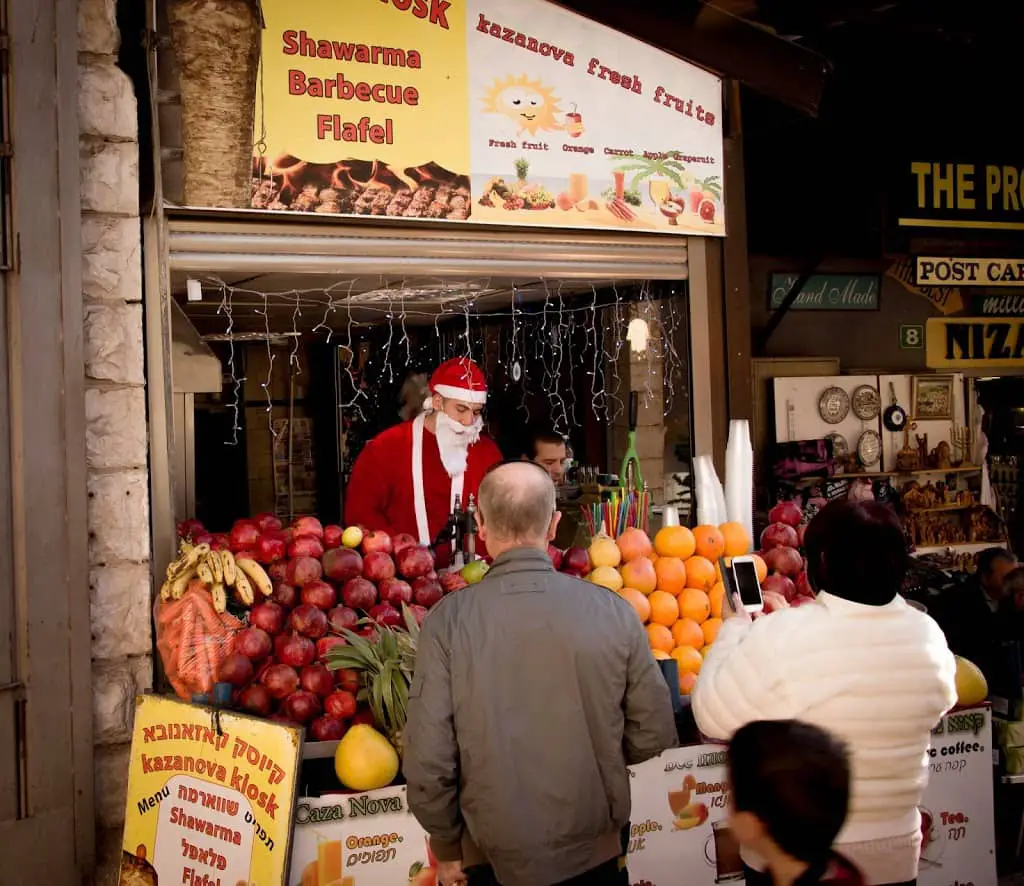
Traffic
One of my strongest experiences of visiting Nazareth is traffic. During our latest visit (on Saturday before Christmas), there was almost no traffic when we arrived early. But in the afternoon, the roads were packed. We started standing in a traffic jam inside the parking lot and crawled slowly out of the city. It took us over an hour and a half to get out of the town (several km).
Moreover, besides the traffic, the roads themselves were awful. They are very narrow, and for some reason, the asphalt was scraped in many places. Such an infrastructure level is more similar to what you see in the movies about Africa.
It was the first time I saw human semaphores. In narrow streets where two cars can not pass, children shout out who should drive and how much. They were very helpful. Though I did not understand what they were saying (they shouted in Arabic), their hand movements were self-explanatory. I would gladly skip such an experience, so keep to the main streets. I have to mention that we used Waze, and it took us through a side road. But, since buildings are very dense, in some places, the phone lost the GPS signal and, in the end, returned to the main street. This detour added probably half an hour to our trip. So as I said, keep to the main roads.
But, the top was when a local driver exited the car. Cursed police officers trying to improve the situation blamed them for the traffic. Then he got into the car and drove at a red light. Driving at a red light in front of traffic police officers seemed natural to him and unthinkable to me. The police did nothing.
According to statistics in Israel: Arabs are involved in more accidents than their percentage of the population. An Arab driver is 2 to 3 times more likely to get involved in a car accident than a Jewish driver. Psychologists say that since many do not accept the Israeli government and its rules, they also do not accept traffic rules. The purpose of this section is not to scare you, but you need to be more careful and expect the unexpected. Overall, driving in Israel is probably more aggressive than in Western Europe. Thus consider taking public transport to the city center.
Summary
Nazareth is more than just a city with religious importance. There are additional places like the market and Nazareth village. And a typical visit to the town will last anywhere from several hours to a full day.
Have you ever been to Nazareth? Tell us in the comments below.
That’s all for today, and I’ll see you in future travels!
Stay Tuned!
Additional Resources
Here are several resources that I created to help travelers:- Trip Planner with Attractions and Itineraries is the page that will help you create your perfect travel route.
- What is the Best Time to visit Israel? To answer this question, we will consider the weather, prices, holidays, festivals, and more.
- Information and Tips for Tourists to Israel will answer the most common questions tourists have about Israel (including safety, passports, weather, currency, tipping, electricity, and much more).
- Israel National Parks and Nature Reserves include a complete list, top ten, map, tickets (Israel Pass, Matmon, combo), and campsites.
- If you are looking for things to do, here are the pages for Jerusalem, Tel Aviv, Haifa, Sea Of Galilee, Akko (Acre), Eilat, Nazareth, Safed (Tzfat), and Makhtesh Ramon.




